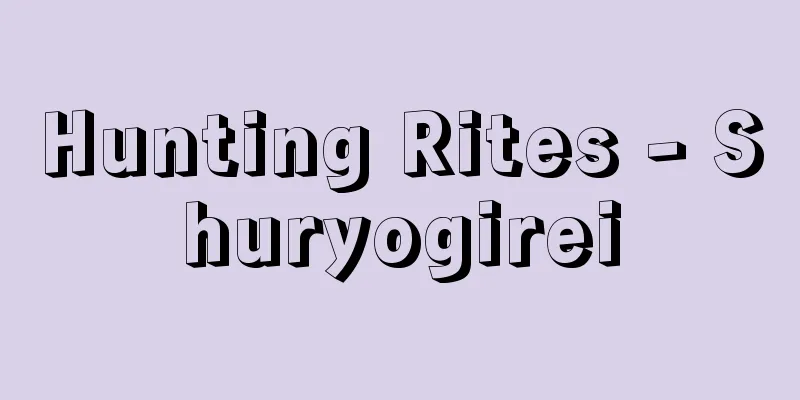Hunting Rites - Shuryogirei

|
Hunting in Japan can be broadly divided into individual "small hunts" and "communal hunts" (large hunts) targeting large animals such as bears, wild boars, deer, and chamois, the latter of which has mainly been carried out by professional mountain hunter groups known as Yamadachi or Matagi. Until recently, spears and machetes were used for "hole hunting" bear hunting, but the form of "bow and arrow hunting" has long since disappeared, and has now been completely replaced by "gun hunting." However, as can be seen from names such as "Yamichi" (ballistic trajectory), "Ichi-no-ya, Hatsu-ya" (first shot), "Yaba" (gun preparation area), and "Yaguchi-iwai" (first hunt celebration), some very old "hunting" customs can still be seen today, which are accompanied by many special magical and religious rites. There are several "Matagi groups" in the hunting villages of the Tohoku mountain region, led by a leader called "Sukari (Shikari)". Each group is generally made up of five or six members, and when hunting season comes, they will purify themselves and move on to a long period of mountain hunting. Their range of activity used to be wide, extending to the depths of Oshu and Shinetsu, and they would often live in huts in the mountains while chasing prey. There are "taboo words" unique to mountain life, called "Yamakotoba", and the unique "mountain etiquette" based on the ancient belief in the mountain god seems to have been strict. Hunter groups in the Chubu and Kyushu mountain regions seem to have lived a similar mountain life, and have retained some old hunting rituals until recent years. [1] First Arrow Celebration When a person who has just become a hunter catches his first prey, he celebrates by inviting fellow hunters to a banquet. It is also called the arrow-firing celebration or the arrow-opening ceremony, and was also a ceremony to acknowledge that the person had become a fully-fledged hunter. [2] Hair Festival and Blood Festival These were rituals performed when butchering a bear, deer, wild boar or other prey on-site. Although there were some differences between groups, they were generally divided into two categories: the butchering ritual known as the "hair festival" or "kebokai" (celebration), and the "purification" ritual known as the "blood festival" or "chibarai" (exorcism). In the former, the prey was butchered in a set manner, and the innards were shared and eaten by everyone. The parts to be distributed were also determined according to the role of the hunter. In the latter ritual, the "head" of the prey was the main object of worship to the "mountain god," giving thanks for the "blessings of the hunt" and praying for an even better catch. The "chants" and "spells" used for this ritual were passed down from group to group for a long time, and some were even written down in so-called "secret books." [3] Celebration of a Thousand Deer: A celebration of thanks for catching a large number of deer. Memorial monuments at the foot of Mt. Zao bearing inscriptions such as "Memorial service for a thousand deer" and "Memorial service for two thousand deer" are of this type. They are similar to the "big catch celebrations" held in fishing villages, but only faint traces of the tradition remain today. [4] Other The custom of firing a gun to express gratitude to the “mountain god” after bringing down prey still remains in widespread use today. There is also a widespread tradition of preparing special gun rounds called “Inochidama (life ball), Hitotsutama (one shot), Kintama (gold ball), Gintama (silver ball)” and of shooting one of them when encountering evil spirits in the mountains in order to escape danger. There were also unique customs in the distribution of the prey in communal hunting. Although the common method was to distribute the prey equally, using methods such as "sabawake, fuchowake," there were also often special distributions based on each person's achievements and roles, and in the latter case in particular, special distributions were made according to the merits and roles of each person, with special treatment being given to those who had made special contributions in bringing down the prey. In boar hunting, this was the "tomeya" (finishing the kill), in deer hunting, the "hatsuya, ichinoya" (first arrow), and in bear and antelope hunting, the "ichinoyari, first spear." These special distributions were called "yatoku" or "sadamasu," and often involved the skin, horns, and head of the animal. In the southern Kyushu mountainous region, special distributions were given to those who hunted the dogs and those who performed the dissection, called "inu damasu, hocho damasu." There was also a practice of giving a small share to people present at the scene other than the hunters, called "mi damasu." If one arrived at the prey before it died, they would be given a share of the catch, which was called a "contest." Since the prey was essentially "ownerless," this old-fashioned way of thinking probably remained in hunting. [Toshimi Takeuchi] Hunting God BeliefThe primary object of worship for hunters was the "mountain god," who prayed exclusively for a good catch and offered thanks when they caught a catch. However, this is quite different from the "mountain god" worshipped by farmers and lumberjacks, and of course has no connection to the Shinto doctrine. The deity is thought to have various characteristics, and although many consider her to be a goddess, this is not always consistent, and of course there is no unique name for her. However, they were considered to be spirits that oversee the mountainous areas where hunting is conducted and grant the blessings of hunting, and were to be "feared and cautious," and they shared the common feature of being accompanied by strict traditions of taboo. Many matagi groups in the Tohoku region have preserved old records such as "Yamatate Nemoto Maki" and "Yamatate Yuraiki," which convey the "true meaning of the profession," and similar "hunting texts" were also passed down in other regions. Many of them record the "origins of professions" that are rooted in belief in mountain gods, and also record mountain hunting spells, but the "traditions of ancestral gods and tales of the origins of professions" found there can be broadly divided into three types. That is, (1) the story of Manzaburo Mountain God, or Iwaji Iwazaburo, (2) the story of the Kariba Myojin lineage, and (3) the story of Oomakoma, or Oonanjikonanji. (1) is commonly known as the "Nikko school" and can already be found in the Nikko-san Engi. (2) is said to be the "Koya school" and, as written in the Koyasan Kyuki, is a Kariba Myojin lineage related to the founding of Koyasan by Kobo Daishi. (3) is preserved in southern Kyushu and the central mountainous region, and is considered to be an old type that has not undergone syncretism with Shugendo Buddhists, but it still has a connection with the "Kumano no Honji Tan" in the Shintoshu. In any case, all three of them say that a "master hunter" assisted the mountain god or guided a high priest to the temple, and thus obtained the special permission to kill as he pleased. In the legend of (3), only the younger of two brothers who were hunters sought the "aid of the gods," and so only his grandson became a legitimate hunter and received the blessings of the mountain gods. In other words, (2) is attached to the legend of the founding of Koyasan, and (1)'s "Nikko school" lineage is a form that has been modified by the mountain ascetic groups based on Mount Nikko, while (3) seems to remain an older folk tale, but it still shows a form that is connected to the "Kumano Honji Tan." In any case, the hunter groups who pursued the birds and animals that had "no owner" in the mountains claimed to have the privilege of being able to hunt freely with the "special permission of the gods and Buddhas" based on these legends, and ordinary farmers also widely recognized this. In a sense, it was a display of the privilege of "authorization to hunt" and also proof that they were legitimate hunters. There is also a widely held legend that the "mountain god" likes "stonefish," and people would offer them to the mountain god, or carry the "dried fish" with them when hunting as a "charm" to urge the mountain god for a good haul. On the other hand, there is also a legend that the stonefish itself blesses with "hunting bounty," so there seems to be a strange connection between the belief in the mountain god and the stonefish, but the origin of this is unclear. It is quite common for hunters to refer to "hunting luck" as "orca" and to worship the "orca god, or orca mountain god" as the object of prayers for a good hunt. The "orca" is said to be a kind of "spirit" that brings good hunting, and there was a custom of receiving some "orca" from a friend who had good hunting luck, and it was also said that if you took out the bullet that had brought down your prey and mixed it into a new bullet, you would be blessed with good hunting luck. In any case, with hunting being governed entirely by chance, there was no choice but to pray to the mountain god or perform various spells and wait for good luck to come, so old beliefs and magical traditions remained for a long time. [Toshimi Takeuchi] "Japanese Folk Culture Series 5: Mountain Folk and Sea Folk" edited by Obayashi Taryo (1983, Shogakukan)" ▽ "Research on Hunting Folklore, Continued Research on Hunting Folklore, Research on Hunting Folklore Part 2" by Chiba Tokuji (1969-77, Kazama Shobo)" ▽ "The Life of the Mountain Folk" (included in The Definitive Collection of Yanagita Kunio Vol. 4, 1963, Chikuma Shobo) Source: Shogakukan Encyclopedia Nipponica About Encyclopedia Nipponica Information | Legend |
|
日本の狩猟は、個人的な「小狩猟」と、クマ、イノシシ、シカ、カモシカなどの大形獣を目がける「共同狩猟」(大狩猟)とに大別できるが、後者は主としてヤマダチ、マタギなどとよばれてきた専業的な山間の狩人(かりゅうど)団によって行われてきた。「穴籠(ごも)り」のクマ猟などには近年まで槍(やり)や山刀が用いられてはいたが、しかし「弓矢猟」の形はすでに失せて久しく、いまは「銃猟」にまったく移行している。しかし「ヤミチ」(弾道)、「一の矢、初矢(そや)」(初弾)、「矢場」(銃の構え場)、「矢口祝」(初猟祝い)などの名称が残るように、かなり古い「狩り」の習俗がいまもみられ、特殊な呪術(じゅじゅつ)宗教的儀礼を幾多伴っている。東北山地の狩人集落にはいくつかの「マタギ組」があって、「スカリ(シカリ)」とよぶ頭(かしら)(指揮者)に率いられてきた。おおむね5、6人の仲間でほぼ固定しており、猟期になると、一同「精進潔斎」のうえ長期間の山猟生活に移った。その行動範囲もかつては広く奥羽・信越の奥地に及び、山中に「小屋住い」を重ねて獲物を追い歩いた。「山ことば」という山中生活独自の「忌みことば」があり、また古い山の神信仰に基づく特異な「山中作法」も厳しかったようである。中部・九州山地の猟人団もほぼ同趣の山中生活を送ってきたようで、いくつか古い狩猟儀礼を近年まで残してきた。 〔1〕初矢祝い 「猟師入り」した者が初めて獲物をしとめたおりの祝いで、狩人仲間を招待して宴を張る。矢やき祝い、矢開きともいい、「一人前の狩人」になる承認儀礼でもあった。 〔2〕毛祭り、血祭り クマ、シカ、イノシシなどの獲物を現場で解体する際の儀礼で、仲間ごとに多少の相違はあったが、おおむねは「毛祭り、毛ぼかい(祝)」という解体の際の作法と、「血祭り、血バライ(祓)」などとよぶ「浄(きよ)め」の作法に区分される。前者では一定作法によって解体したうえ獲物の臓物を一同に分け合って共食することが主となり、狩りの役割に従って分配する部分も決まっていた。後者の作法は獲物の「頭」を主対象に「山の神」を祀(まつ)り、「狩りの恵み」を謝し、いっそうの豊猟を祈念する形で、その際の「唱え言」や「呪文(じゅもん)」の類が仲間ごとに久しく伝承されていて、いわゆる「秘伝書」として書き留められたものもある。 〔3〕千匹祝い 獲物を多数しとめた感謝の祝い。蔵王山麓(ざおうさんろく)などに「鹿(しか)千匹供養」「鹿二千供養」などと記した供養碑がいまに残るのもその類であろう。漁村の「大漁祝い」と同類だが、その伝承は今日かすかに残るだけである。 〔4〕その他 獲物をしとめると、発砲して、「山の神」にお礼の意を表す風はいまも広く残り、また「命玉(いのちだま)、一つ玉、金玉、銀玉」などとよぶ特製の銃丸を用意し、山中で魔性のものに会った際にはそれを撃てば難を逃れるといった伝承なども広く行われていた。 共同狩猟の獲物の配分方式にも特異な風習がみられた。「サバワケ、フチョウワケ」などという平等分配の方法が一般的ではあったが、それにあわせて各人の手柄や役割に応じて特殊の配分が行われることが多く、とくに後者では獲物をしとめるうえで特別の功労のあった者が優待された。イノシシ猟では「留矢(とめや)」(とどめをさす)、シカ猟では「初矢、一の矢」、クマ・カモシカ猟では「一の槍、初槍」などがそれにあたり、その特殊配分を「矢徳(やとく)、射ダマス」などとよび、多く皮、角(つの)、頭部などが与えられることになっていた。また九州南部山地などでは「犬ダマス、包丁ダマス」と称して、犬をかける者や解体の執刀人にも特別の配分をした。また狩人以外の臨場者にも「見ダマス」などといって若干の配分を行う慣行もあった。獲物が絶息しないうちにその場に立ち会えば、「出合い勝負」などといって一人前の配分にあずかれたわけで、本来「無主物」相手ゆえ狩猟にはこうした古風な考え方も残ったのであろう。 [竹内利美] 狩猟神信仰狩人の第一の信仰対象は「山の神」で、もっぱら豊猟を祈念し、獲物があればまずそれに奉謝した。しかし農民や木こりの信仰する「山の神」とはかなり別趣で、もちろん神道教義のものとはかかわりがない。その神格はいろいろに思念されていて、女神とするものが多いが、かならずしも一定せず、もちろん個性的な神名も伝わらない。ただ狩猟の場である山岳地帯をしろしめし、猟の恵みを与える神霊として「畏(おそ)れ慎む」べきものと思念され、厳しい禁忌伝承を伴っていた点は共通していた。東北のマタギ組には『山立根本巻』『山立由来記』などという「職の本縁」を伝える旧記を伝存するものが多く、また同類の「狩猟伝書」は他地方にも伝えられていた。多くは山の神信仰に根ざす「職の由来」を記すもので、あわせて山猟の呪法などを書き留めてあるが、そこにみられる「祖神伝承、職の本縁譚(たん)」はおよそ三つの型に大別できるようである。 つまり、(1)万三郎山神、または磐次磐三郎(ばんじばんざぶろう)物語、(2)狩場明神系の物語、(3)大摩小摩、または大汝小汝(おおなんじこなんじ)の物語である。(1)は「日光派」系と通称され、すでに『日光山縁起』などにもみえるところである。(2)は「高野(こうや)派」系といわれるもので、『高野山(こうやさん)旧記』に記されると同じく、弘法(こうぼう)大師の高野開山にまつわる狩場明神系伝承である。(3)は南九州や中部山地に伝存されるもので、修験(しゅげん)仏徒の習合を経ぬ古い型とみられるが、『神道集』の「熊野の本地譚」となお一脈のつながりをもっている。ともかく三者とも「狩りの名手」が山の神を助け、あるいは高僧の開山の手引きをして、殺生自在の特認を得たと伝えるところで、(3)の伝承では兄弟の狩人のうち弟のみが「神の助力」に努めたゆえ、その末孫だけが正統の狩人になり、山の神の恵みにあずかれると伝える。つまり(2)は高野開創伝承に付会し、また(1)の「日光派」系は日光山に拠(よ)る修験団の修飾を経た形で、(3)はより古い民間伝承のままらしいが、なお「熊野本地譚」につながる形を示してはいる。ともかく、山中に「無主」の鳥獣を追う狩人団は、こうした伝承を根拠に自在の狩猟活動を「神仏の特認」のもとに行いうる特権を保持すると称し、一般農民もまたそれを広く認めたのである。いわばそれは「狩猟認許」の特権表示であり、また正統の狩人である証明でもあった。 また「山の神」が「オコゼ魚」を好むという伝承も広く残り、それを山の神に供えたり、あるいは狩猟の際その「干物」を携えて豊猟を山の神に催促する「まじない」なども行われた。また一方にはオコゼ自体が「狩りの幸」を恵むという伝承もあって、山の神信仰とオコゼ魚は奇妙なかかわりをもつもののようだが、その原拠は分明でない。 狩人が「猟運」を「シャチ」といい、「シャチ神、シャチ山の神」を豊猟祈願の対象として祀ることもかなり広くみられる。「シャチ」は猟をもたらす「精霊」の類らしく、猟運に恵まれた仲間から「シャチ」を分けてもらう作法もあり、また獲物をしとめた弾丸は抜き出して、それを新しい弾丸に混ぜ入れると、猟運に恵まれるともいっていた。ともかく、まったくの偶然に支配される狩猟では、山の神に祈願したり、あるいはいろいろの呪法を尽くして、好運の訪れを待つよりほかなかったので、古い信仰や呪術伝承が久しく残ったのである。 [竹内利美] 『大林太良編著『日本民俗文化大系5 山民と海人』(1983・小学館)』▽『千葉徳爾著『狩猟伝承研究』『続狩猟伝承研究』『狩猟伝承研究後篇』(1969~77・風間書房)』▽『「山民の生活」(『定本柳田国男集4』所収・1963・筑摩書房)』 出典 小学館 日本大百科全書(ニッポニカ)日本大百科全書(ニッポニカ)について 情報 | 凡例 |
<<: Delay in receipt - Juryouchitai
Recommend
Ointment - What
External preparations. Semi-solid ointments made b...
Mali Empire - Mali Empire (English spelling)
The Malinke Empire flourished from the 13th to the...
Arnica montana (English spelling) Arnicamontana
…[Hiroji Koyama]. . … *Some of the terminology th...
Eicosapentaenoic acid
An unsaturated fatty acid, oily liquid. It is abb...
Suspension of civil rights
Civil rights are generally defined as the suspensi...
Equation of motion
An equation used to understand the motion of obje...
Space Transportation System
…Spacelab is a nickname that is an abbreviation o...
Elton's Pyramid - Elton's Pyramid
…If these relationships are illustrated and stack...
Betel vine (English spelling) betelvine
…An evergreen climbing plant of the Piperaceae fa...
Micropterigidae
...A general term for insects of the Lepidoptera ...
Chlorophyllum molybditis
…A similar mushroom, whose white flesh turns red ...
Serveto, M.
…Spanish physician and free thinker. His Spanish ...
Emmara - Imaara
...The ancient imperial court rituals of farming ...
Kiji
(1) The Kii no Kuni no Miyatsuko family. Accordin...
American War of Independence
The war in which the thirteen North American colon...









